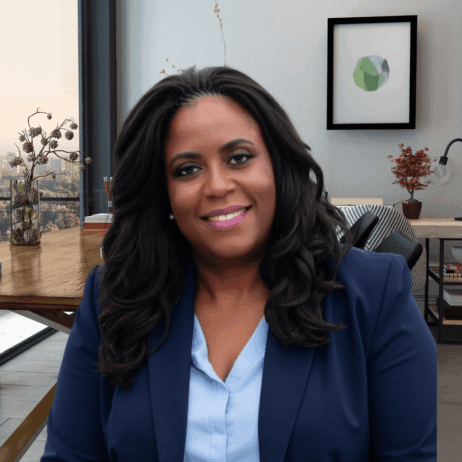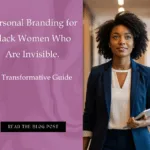September 21, 2025


A Stark Reality. Over 300,000 Black Women Have Been Laid Off
More than 300,000 Black women have been laid off since President Trump’s return to office. Driven by sweeping federal job cuts, weakened diversity and inclusion programs, and shifts in economic priorities. (wabe.org) According to Essence their unemployment rate has surged from around 5.4% to 7.5%, a devastating jump that reflects not voluntary exits, but widespread terminations and structural pushouts.
For Black women, these layoffs are not just statistics. They are our lived experiences of careers abruptly interrupted, financial stability threatened, and futures placed in jeopardy. They underscore the reality that systemic inequities make Black women some of the first to be fired in downturns and the last to be rehired in recoveries.
Losing a job under these circumstances isn’t just about economics. It is about identity, visibility, and dignity. It’s about being pushed out of spaces where you’ve worked tirelessly to prove your value. But being laid off, while painful, can also serve as a turning point. It forces the question: How do I take back control of my story?
That’s where personal branding becomes vital. It allows Black women to reframe the narrative, showcase resilience, and build a professional identity that cannot be erased by a pink slip.
Understanding the Unique Challenges Black Women Face in the Job Market
Workplace bias and underrepresentation
Black women are often underrepresented in leadership positions and overrepresented in industries vulnerable to layoffs. Unconscious bias, lack of sponsorship, and systemic inequities can make re-entering the workforce even harder.
The emotional impact of sudden unemployment
Beyond finances, a layoff can trigger feelings of doubt, shame, grief, and anxiety. For me, it hurt and guilt when my child made a comment as I dropped her off at daycare one day, “Everybody else’s mommy goes to work except my mommy.” I didn’t think she was paying attention. That kind of pain just adds to the misery of being unemployed.
For Black women, all of this is compounded by cultural expectations of strength and resilience. Sometimes leaving little room for us to process vulnerability.
Breaking stereotypes and reclaiming narratives
Personal branding gives Black women the chance to control the narrative, to highlight their expertise, showcase their leadership, and push back against stereotypes.
What Is Personal Branding and Why It’s Crucial Now
Defining personal branding in simple terms
Personal branding is how you present your skills, personality, and values to the world. It’s not about being someone else. It’s actually about amplifying who you already are.
Difference between personal branding and self-promotion
Self-promotion can feel uncomfortable, but personal branding isn’t bragging…it’s storytelling. It’s sharing your experiences in a way that demonstrates your value. I cover the importance of storytelling in this blog Why Storytelling is Your Secret Weapon for the C-Suite.
Why layoffs can be an opportunity for reinvention
Instead of being a setback, a layoff can act as a pivot point. It’s the perfect time to refine your professional identity and align your next career move with your passions.
Step 1: Assessing Your Skills, Strengths, and Values
Conducting a career self-audit
The first step in personal branding after a layoff is taking inventory. Think of it like organizing your closet. You need to know what you already have before deciding what to wear. A career self-audit involves reflecting on your experiences, achievements, and growth areas. Write down past roles, major projects, and skills you’ve mastered. This will give you a clear picture of your professional toolkit.
💡 In my VISIBLE Executive Brand Method™, I guide clients through a structured audit that uncovers hidden strengths and reframes “gaps” as growth opportunities. This shift is often the key to rebuilding confidence after a layoff.
Step 2: Crafting a Personal Brand Statement That Stands Out
How to write your brand story
Your brand story should weave together your background, skills, and passions into a cohesive narrative. Instead of a dry resume summary, frame it as: “I help [who] achieve [what] by using [how].” For example:
“I help mission-driven organizations amplify their voices by blending data storytelling with inclusive leadership.”
💡 Inside the VISIBLE Executive Brand Method™, I help women translate their career journeys into compelling brand stories. Stories that communicate value with clarity, confidence, and authenticity.
Creating a value-driven elevator pitch
Your elevator pitch is a 30–60 second introduction that communicates who you are, what you do, and why it matters. This is what you’ll use in interviews, networking, and online bios. Keep it short, impactful, and aligned with your long-term goals.
Using authenticity as a competitive advantage
Authenticity is magnetic. Instead of trying to fit into someone else’s mold, highlight the unique perspectives you bring. For Black women, this often means celebrating cultural heritage, resilience, and community-driven leadership.
Step 3: Building a Strong Online Presence
Optimizing LinkedIn for visibility
LinkedIn is your digital storefront. Optimize it by updating your headline, summary, and experience sections with clear, keyword-rich descriptions. Use a professional headshot and a banner image that reflects your personal brand. Engage regularly by commenting on posts, sharing industry insights, and writing short thought pieces.
The power of professional headshots and visuals
Visuals make a difference. A professional headshot communicates confidence and approachability. Beyond LinkedIn, consistent brand visuals (colors, fonts, style) across resumes, websites, and social media profiles strengthen your recognition factor.
Leveraging social media to showcase expertise
Choose platforms where your target audience hangs out, LinkedIn for professional engagement, Instagram for storytelling, or YouTube for in-depth tutorials. View my Youtube channel for 700+ videos. Subscribe while you’re there to receive notice when new videos drop. Sharing insights, hosting live sessions, or simply commenting thoughtfully on others’ content helps establish you as a thought leader.


Step 4: Networking With Purpose
How to tap into alumni and affinity networks
Networking doesn’t have to feel transactional. Start with communities you’re already part of college alumni networks, sororities, or Black professional organizations like Black Women in Business Collective or National Coalition of 100 Black Women. Remember that networking is about building a relationship that’s give and take. Versus ask, ask, ask (because that just feels creepy🤷🏾♀️). Check out my blog Top 20 Networking Mistakes (And How to Avoid Them) for a deeper dive.
The importance of mentorship and sponsorship
A mentor provides guidance, but a sponsor actively advocates for you in rooms you’re not in. Seek both. Build authentic relationships by offering value in return, whether through collaboration, referrals, or sharing resources.
Attending conferences, panels, and industry events
Visibility is key. Attending (or speaking at) events positions you as a leader in your field. Even virtual panels or webinars can help you connect with people who matter. Pro tip: always follow up with new contacts within 48 hours to stay memorable.
Step 5: Showcasing Expertise Through Content Creation
Writing thought leadership articles
Publishing articles on LinkedIn or platforms like Medium allows you to share your expertise while boosting your personal brand. You can read my Medium blogs here. Topics could include lessons learned from layoffs, leadership tips, or navigating diversity in the workplace.
Speaking engagements and podcasts
Guest appearances on podcasts or panels expand your reach beyond your immediate circle. Share your journey, challenges, and expertise. You never know when your story may inspire someone while also elevating your visibility.
Sharing knowledge on niche platforms
Don’t overlook smaller communities like industry-specific forums, Slack groups, or newsletters. These targeted spaces often lead to deeper, more meaningful engagement than broad social media platforms.
Step 6: Upskilling and Continuous Learning
Identifying certifications that matter
A layoff is a great time to add certifications that enhance your credibility. For example, if you’re in marketing, certifications from Google Analytics or HubSpot can set you apart. For leadership, programs from Harvard Online or Coursera add value.
Free and low-cost learning opportunities
Not all upskilling requires a big budget. Websites like edX, Skillshare, and LinkedIn Learning offer affordable or free courses across industries. Many professional organizations also provide scholarships for Black women pursuing career development.
Staying relevant in a rapidly changing job market
Industries evolve fast. Stay ahead by following thought leaders, subscribing to industry newsletters, and engaging in continuous skill development. Being adaptable makes your personal brand future-proof.
Step 7: Developing Confidence and Resilience
Overcoming imposter syndrome
Imposter syndrome, feeling like you’re not “enough”, hits many high-achieving Black women. Combat it by tracking your wins in a “brag book.” Revisit it whenever doubt creeps in.
Practicing self-advocacy and negotiation
Your brand isn’t just about how others perceive you. It is also about how you advocate for yourself. Practice asking for promotions, better pay, or visibility in projects. Negotiation is a skill that reinforces your worth. These skills will follow you if you decide entrepreneurship is the next best step for you.
Building a supportive community
No one thrives alone. Whether it’s a mastermind group, accountability partner, or online sisterhood, surrounding yourself with supportive peers fuels resilience during career transitions.
Success Stories: Black Women Who Rebranded After Layoffs
Real-life examples of career pivots
Take the story of M., a corporate marketer laid off during the pandemic. Instead of retreating, she started a personal blog on inclusive marketing strategies. Within months, she was consulting for her own business.
Or consider A., a project manager who transitioned into tech after being laid off. By branding herself as a “bridge-builder between people and technology,” she landed a role at a top startup.
Lessons learned from resilience
The common thread in these stories? They didn’t let layoffs define them. They knew when to ask for help. They used personal branding to transform uncertainty into opportunity. Just like Black women always do.
Tools and Resources to Elevate Your Personal Brand
Branding templates and resume builders
Platforms like Canva and Zety offer free templates for resumes, personal websites, and social media graphics. Consistency across visuals strengthens your brand identity.
Online communities and support groups
Join spaces like Black Career Women’s Network or Women of Color in Tech. These communities provide mentorship, job leads, and accountability.
Recommended books and podcasts
- The Memo by Minda Harts (career advancement for women of color)
- Year of Yes by Shonda Rhimes (embracing opportunities)
- Podcasts like Side Hustle Pro or Brown Ambition for inspiring career journeys.
Turning Setbacks Into Comebacks
The reality is sobering: over 300,000 Black women have been laid off, not because they lacked talent. But because of structural inequities and systemic pushouts. These numbers represent careers disrupted, voices silenced, and communities impacted. Yet, they also represent an undeniable truth…
…Black women are resilient, powerful, and more than capable of reclaiming their narratives.
Being laid off is not the end of your story. It can be the beginning of a strategic reinvention. One where your personal brand becomes your shield, your voice, and your superpower. When you define who you are and amplify your expertise, no employer, no policy, and no layoff can take that away.
This is where my VISIBLE Executive Brand Method™ comes in. Designed specifically for high-achieving women navigating career transitions, this mini coaching program helps you:
- Clarify your unique brand story and strengths.
- Build a confident, authentic online presence.
- Position yourself for leadership roles and new opportunities.
- Network with intention and influence.
If you’re ready to turn a layoff into a comeback story, the VISIBLE Executive Brand Method™ will give you the tools and support you need to stand out, step forward, and shine. Even in the face of setbacks.
Your next chapter isn’t just about getting rehired. It’s about stepping into your power, visibility, and influence like never before.
🌟 Ready to Activate Your Executive Brand? 🌟
In my 1:1 VISIBLE Executive Brand Method™ Mini Coaching Package, we’ll work together over 5 focused sessions to transform your professional identity and reposition you as undeniable. By the end, you’ll walk away with:
✨ A Personal Brand – one that reflects your true leadership identity and positions you with credibility, confidence, and clarity in the boardroom or marketplace.
✨ A Leadership Narrative – a clear, compelling story of impact and vision that communicates your value in the language executives, boards, clients, or investors respect.
✨ A Mission & Message – a sharp statement of your values and purpose that positions you as a thought leader and makes your contributions undeniable across industries.
✨ A Visibility Roadmap – a tailored, step-by-step plan ensuring you’re not just in the room, but remembered, recommended, and selected for promotions, board seats, or entrepreneurial success.
👉🏾This is your invitation to rise from layoff to legacy. Let’s build a brand that opens doors, commands influence, and cements your place at the table. Click the button below for the details.
FAQs About Personal Branding After a Layoff
Q1. Is personal branding really necessary after a layoff?
Yes! It helps you control your narrative, build confidence, and stand out in a competitive market.
Q2. What’s the first step I should take to rebrand myself?
Start with a career self-audit to identify skills, strengths, and passions. This forms the foundation of your brand.
Q3. How can I network without feeling like I’m asking for favors?
Focus on building genuine relationships, share resources, give feedback, and show interest in others’ work. Networking is a two-way street.
Q4. Can I pivot careers after a layoff using personal branding?
Absolutely. Many Black women successfully pivot by highlighting transferable skills and aligning their brand with new industries.
Q5. How do I overcome the fear of self-promotion?
Shift your perspective: you’re not bragging, you’re sharing value. Storytelling makes it easier and more authentic.
Q6. What online platforms are best for personal branding?
LinkedIn is essential, but Pinterest, Instagram, and niche platforms can also amplify your reach depending on your industry.


I know what it feels like to stumble through a career transition. I flubbed my first move from the military so badly it took me over a decade to rebuild my confidence. That experience fuels my mission today.
I’m Dr. Twanna, a Certified Executive Coach and ICF PCC who helps Black women executives secure bigger bonuses, increase visibility, and create the space to actually enjoy life. I understand the weight of imposter syndrome and the pressure to constantly prove yourself at the top. My work equips leaders with the tools, strategies, and confidence to navigate career challenges with clarity and authority.
✨ Ready to shift from overworked to unstoppable? Let’s talk.
Read my latest blogs…
- 7 Powerful Strategies to Brand & Thrive After a Layoff


 A Stark Reality. Over 300,000 Black Women Have Been Laid Off More than 300,000 Black women have been laid off since President… Read more: 7 Powerful Strategies to Brand & Thrive After a Layoff
A Stark Reality. Over 300,000 Black Women Have Been Laid Off More than 300,000 Black women have been laid off since President… Read more: 7 Powerful Strategies to Brand & Thrive After a Layoff - Personal Branding for Black Women Who Are Invisible. A Transformative Guide


 The Power of Personal Branding for Visibility Invisibility is exhausting and Black women know it better than anyone else.Every meeting, every boardroom,… Read more: Personal Branding for Black Women Who Are Invisible. A Transformative Guide
The Power of Personal Branding for Visibility Invisibility is exhausting and Black women know it better than anyone else.Every meeting, every boardroom,… Read more: Personal Branding for Black Women Who Are Invisible. A Transformative Guide - The Worker Bee Trap for Black Women Executives. How Over-performance Keeps Us Invisible in Corporate America


 Worker Bee. The Hidden Trap Behind “Hard Work Pays Off” Growing up, many of us were taught the same lesson: If you… Read more: The Worker Bee Trap for Black Women Executives. How Over-performance Keeps Us Invisible in Corporate America
Worker Bee. The Hidden Trap Behind “Hard Work Pays Off” Growing up, many of us were taught the same lesson: If you… Read more: The Worker Bee Trap for Black Women Executives. How Over-performance Keeps Us Invisible in Corporate America - Why Storytelling is Your Secret Weapon for the C-Suite
![Black women executive using storytelling with her team; Why Storytelling is Your Secret Weapon for the C-Suite; find Black executive story; executive coaching for Black women; best Black executive coach NY, best executive career coach near Maryland; find Black executive coach near TX; hire personal branding consultant for black women executives, branding audit services for black female founders, branding strategy package for women of color in business, personal branding coach for black women leaders, fix my executive brand [for black women], rebranding agency for black women-led companies, LinkedIn profile rewrite service for black female executives, corporate headshot photographer specializing in black women professionals, speaker branding package for black women keynote speakers, employer branding consultant for diversity & inclusion,](//twannacarter.com/wp-content/plugins/a3-lazy-load/assets/images/lazy_placeholder.gif)
![Black women executive using storytelling with her team; Why Storytelling is Your Secret Weapon for the C-Suite; find Black executive story; executive coaching for Black women; best Black executive coach NY, best executive career coach near Maryland; find Black executive coach near TX; hire personal branding consultant for black women executives, branding audit services for black female founders, branding strategy package for women of color in business, personal branding coach for black women leaders, fix my executive brand [for black women], rebranding agency for black women-led companies, LinkedIn profile rewrite service for black female executives, corporate headshot photographer specializing in black women professionals, speaker branding package for black women keynote speakers, employer branding consultant for diversity & inclusion,](//twannacarter.com/wp-content/plugins/a3-lazy-load/assets/images/lazy_placeholder.gif)
![Black women executive using storytelling with her team; Why Storytelling is Your Secret Weapon for the C-Suite; find Black executive story; executive coaching for Black women; best Black executive coach NY, best executive career coach near Maryland; find Black executive coach near TX; hire personal branding consultant for black women executives, branding audit services for black female founders, branding strategy package for women of color in business, personal branding coach for black women leaders, fix my executive brand [for black women], rebranding agency for black women-led companies, LinkedIn profile rewrite service for black female executives, corporate headshot photographer specializing in black women professionals, speaker branding package for black women keynote speakers, employer branding consultant for diversity & inclusion,](https://twannacarter.com/wp-content/uploads/2025/08/Why-Storytelling-is-Your-Secret-Weapon-for-the-C-Suite_Twanna-Carter-150x150-png.webp) Why Women Executives Need Strategic Storytelling As women executives, we know how vital it is to shape our narrative and own our… Read more: Why Storytelling is Your Secret Weapon for the C-Suite
Why Women Executives Need Strategic Storytelling As women executives, we know how vital it is to shape our narrative and own our… Read more: Why Storytelling is Your Secret Weapon for the C-Suite - 3 Branding Mistakes That Sabotage Successful Black Women Leaders
![successful Black woman executive standing next to a desk; 3 Branding Mistakes that Sabotage Black Women_Twanna Carter; how to recover from a branding mistake as a black female executive, rebranding strategy after a business mistake black women, fixing a weak personal brand as a woman of color in leadership, managing online reputation for black women executives, how to position myself as an industry expert [black woman], overcoming invisibility as a black woman in corporate america; building authority and credibility as a black female leader; branding for black women who want board positions; how to communicate my value as a black woman executive, personal branding for black women seeking c-suite roles,](//twannacarter.com/wp-content/plugins/a3-lazy-load/assets/images/lazy_placeholder.gif)
![successful Black woman executive standing next to a desk; 3 Branding Mistakes that Sabotage Black Women_Twanna Carter; how to recover from a branding mistake as a black female executive, rebranding strategy after a business mistake black women, fixing a weak personal brand as a woman of color in leadership, managing online reputation for black women executives, how to position myself as an industry expert [black woman], overcoming invisibility as a black woman in corporate america; building authority and credibility as a black female leader; branding for black women who want board positions; how to communicate my value as a black woman executive, personal branding for black women seeking c-suite roles,](//twannacarter.com/wp-content/plugins/a3-lazy-load/assets/images/lazy_placeholder.gif)
![successful Black woman executive standing next to a desk; 3 Branding Mistakes that Sabotage Black Women_Twanna Carter; how to recover from a branding mistake as a black female executive, rebranding strategy after a business mistake black women, fixing a weak personal brand as a woman of color in leadership, managing online reputation for black women executives, how to position myself as an industry expert [black woman], overcoming invisibility as a black woman in corporate america; building authority and credibility as a black female leader; branding for black women who want board positions; how to communicate my value as a black woman executive, personal branding for black women seeking c-suite roles,](https://twannacarter.com/wp-content/uploads/2025/08/3-Branding-Mistakes-that-Sabotage-Black-Women_Twanna-Carter-150x150-png.webp) Why Personal Branding Matters More Than Ever Visibility Equals Value As a Black woman in leadership, your excellence is undeniable. But it… Read more: 3 Branding Mistakes That Sabotage Successful Black Women Leaders
Why Personal Branding Matters More Than Ever Visibility Equals Value As a Black woman in leadership, your excellence is undeniable. But it… Read more: 3 Branding Mistakes That Sabotage Successful Black Women Leaders - Executive Coaching for Black Women. Empowering Unstoppable Success


 Why Executive Coaching Matters for Black Women In today’s fast-paced corporate world, executive coaching for Black women is more than a… Read more: Executive Coaching for Black Women. Empowering Unstoppable Success
Why Executive Coaching Matters for Black Women In today’s fast-paced corporate world, executive coaching for Black women is more than a… Read more: Executive Coaching for Black Women. Empowering Unstoppable Success - Build a Powerful Network They Say. But No One Tells You How!


 To build a powerful network is one of the most influential tools for professional and personal success, yet most people approach it… Read more: Build a Powerful Network They Say. But No One Tells You How!
To build a powerful network is one of the most influential tools for professional and personal success, yet most people approach it… Read more: Build a Powerful Network They Say. But No One Tells You How! - 12 Tips to Successfully Changing Careers


 Changing careers is no longer the rare, risky leap it once was. It’s becoming a normal part of professional life. Whether you’re… Read more: 12 Tips to Successfully Changing Careers
Changing careers is no longer the rare, risky leap it once was. It’s becoming a normal part of professional life. Whether you’re… Read more: 12 Tips to Successfully Changing Careers










+ show Comments
- Hide Comments
add a comment